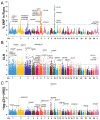Genetic Diversity, Selection Signatures, and Genome-Wide Association Study Identify Candidate Genes Related to Litter Size in Hu Sheep
- PMID: 39273345
- PMCID: PMC11395453
- DOI: 10.3390/ijms25179397
Genetic Diversity, Selection Signatures, and Genome-Wide Association Study Identify Candidate Genes Related to Litter Size in Hu Sheep
Abstract
Hu sheep is a renowned prolific local sheep breed in China, widely distributed across the country due to its excellent reproductive performance. Deciphering the molecular mechanisms underlying the high fecundity of Hu sheep is crucial for improving the litter size of ewes. In this study, we genotyped 830 female Hu sheep using the Illumina OvineSNP50 BeadChip and performed genetic diversity analysis, selection signature detection, and a genome-wide association study (GWAS) for litter size. Our results revealed that the Hu sheep population exhibits relatively high genetic diversity. A total of 4927 runs of homozygosity (ROH) segments were detected, with the majority (74.73%) being short in length. Different genomic inbreeding coefficients (FROH, FHOM, FGRM, and FUNI) ranged from -0.0060 to 0.0126, showing low levels of inbreeding in this population. Additionally, we identified 91 candidate genomic regions through three complementary selection signature methods, including ROH, composite likelihood ratio (CLR), and integrated haplotype score (iHS), and annotated 189 protein-coding genes. Moreover, we observed two significant SNPs related to the litter size of Hu sheep using GWAS analysis based on a repeatability model. Integrating the selection signatures and the GWAS results, we identified 15 candidate genes associated with litter size, among which BMPR1B and UNC5C were particularly noteworthy. These findings provide valuable insights for improving the reproductive performance and breeding of high-fecundity lines of Hu sheep.
Keywords: GWAS; Hu sheep; candidate genes; genetic diversity; litter size; selection signatures.
Conflict of interest statement
The authors declare no conflicts of interest.
Figures






Similar articles
-
Comparative whole-genome resequencing to uncover selection signatures linked to litter size in Hu Sheep and five other breeds.BMC Genomics. 2024 May 15;25(1):480. doi: 10.1186/s12864-024-10396-x. BMC Genomics. 2024. PMID: 38750582 Free PMC article.
-
Litter Size of Sheep (Ovis aries): Inbreeding Depression and Homozygous Regions.Genes (Basel). 2021 Jan 18;12(1):109. doi: 10.3390/genes12010109. Genes (Basel). 2021. PMID: 33477586 Free PMC article.
-
Exploring Runs of Homozygosity and Heterozygosity in Sheep Breeds Maintained in Poland.Genes (Basel). 2025 Jun 14;16(6):709. doi: 10.3390/genes16060709. Genes (Basel). 2025. PMID: 40565601 Free PMC article.
-
Identifying Candidate Genes for Litter Size and Three Morphological Traits in Youzhou Dark Goats Based on Genome-Wide SNP Markers.Genes (Basel). 2023 May 29;14(6):1183. doi: 10.3390/genes14061183. Genes (Basel). 2023. PMID: 37372363 Free PMC article. Review.
-
Genome-wide selection signatures detection in Shanghai Holstein cattle population identified genes related to adaption, health and reproduction traits.BMC Genomics. 2021 Oct 15;22(1):747. doi: 10.1186/s12864-021-08042-x. BMC Genomics. 2021. PMID: 34654366 Free PMC article. Review.
Cited by
-
Whole-Genome Resequencing in Sheep: Applications in Breeding, Evolution, and Conservation.Genes (Basel). 2025 Mar 22;16(4):363. doi: 10.3390/genes16040363. Genes (Basel). 2025. PMID: 40282323 Free PMC article. Review.
-
Analysis of Population Structure and Selection Signatures in Two Iraqi Fat-Tailed Sheep Breeds.Vet Med Sci. 2025 Sep;11(5):e70584. doi: 10.1002/vms3.70584. Vet Med Sci. 2025. PMID: 40859468 Free PMC article.
-
Genetic diversity and selection signatures in sheep breeds.J Appl Genet. 2025 Sep;66(3):675-687. doi: 10.1007/s13353-025-00941-z. Epub 2025 Jan 30. J Appl Genet. 2025. PMID: 39883377 Free PMC article.
References
-
- Amer P.R., McEwan J.C., Dodds K.G., Davis G.H. Economic values for ewe prolificacy and lamb survival in New Zealand sheep. Livest. Prod. Sci. 1999;58:75–90. doi: 10.1016/S0301-6226(98)00192-4. - DOI
MeSH terms
Substances
Grants and funding
LinkOut - more resources
Full Text Sources

